Related Research Articles

Canastota is a village located inside the Town of Lenox in Madison County, New York, United States. The population was 4,556 at the 2020 census.
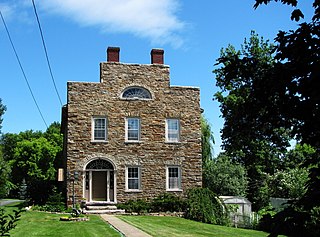
Keeseville is a hamlet in Clinton and Essex counties, New York, United States. The population was 1,815 at the 2010 census. The hamlet was named after the Keese family, early settlers from Vermont. It developed along the Ausable River, which provided water power for mills and industrial development.

The Battle of Plattsburgh, also known as the Battle of Lake Champlain, ended the final British invasion of the northern states of the United States during the War of 1812. Two British forces, an army under Lieutenant General Sir George Prévost and a naval squadron under Captain George Downie converged on the lakeside town of Plattsburgh, New York. Plattsburgh was defended by New York and Vermont militia and detachments of regular troops of the United States Army, all under the command of Brigadier General Alexander Macomb, and ships commanded by Master Commandant Thomas Macdonough.

Plattsburgh is a city in, and the seat of, Clinton County, New York, United States, situated on the north-western shore of Lake Champlain. The population was 19,841 at the 2020 census. The population of the surrounding Town of Plattsburgh was 11,886 as of the 2020 census, making the combined population for all of greater Plattsburgh to be 31,727. Plattsburgh lies just to the northeast of Adirondack Park, immediately outside of the park boundaries. It is the second largest community in the North Country region, and serves as the main commercial hub for the sparsely populated northern Adirondack Mountains. The land around what is referred to as Plattsburgh was previously inhabited by the Iroquois, Western Abenaki, Mohican and Mohawk people. Samuel de Champlain was the first ever recorded European that sailed into Champlain Valley and later claimed the region as a part of New France in 1609.

The State University of New York at Plattsburgh is a public university in Plattsburgh, New York. The university was founded in 1889 and officially opened in 1890. The university is part of the State University of New York (SUNY) system and is accredited by the Middle States Commission on Higher Education. SUNY Plattsburgh has 5,109 students, of whom 4,680 are undergraduates.
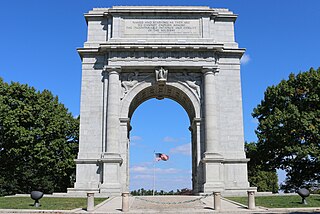
Valley Forge National Historical Park is the site of the third winter encampment of the Continental Army during the American Revolutionary War from December 19, 1777 to June 19, 1778. The National Park Service preserves the site and interprets the history of the Valley Forge encampment. The park contains historical buildings, recreated encampment structures, memorials, museums, and recreation facilities.
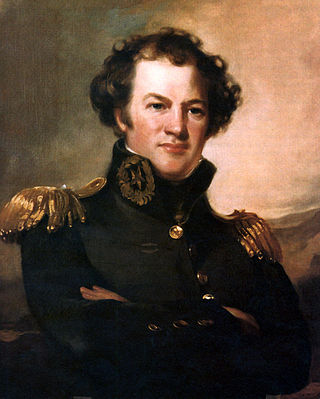
Alexander Macomb was the Commanding General of the United States Army from May 29, 1828, until his death on June 25, 1841. Macomb was the field commander at the Battle of Plattsburgh during the War of 1812 and, after the stunning victory, was lauded with praise and styled "The Hero of Plattsburgh" by some of the American press. He was promoted to Major General for his conduct, receiving both the Thanks of Congress and a Congressional Gold Medal.

The Boston National Historical Park is an association of sites that showcase Boston's role in the American Revolution and other parts of history. It was designated a national park on October 1, 1974. Seven of the eight sites are connected by the Freedom Trail, a walking tour of downtown Boston. All eight properties are National Historic Landmarks.

Fort Griswold is a former American defensive fortification in Groton, Connecticut named after Deputy Governor Matthew Griswold. The fort played a key role in the early stages of the American Revolutionary War, in correspondence with Fort Trumbull on the opposite side of the Thames River. Griswold defended the port of New London, Connecticut, a supply center for the Continental Army and friendly port for Connecticut-based privateers who targeted British shipping. The 17-acre site is maintained as Fort Griswold Battlefield State Park by the Connecticut Department of Energy and Environmental Protection.

The Stephen Collins Foster Memorial is a performing arts center and museum which houses the Stephen Foster Archives at the University of Pittsburgh in Pittsburgh, Pennsylvania, USA. It is dedicated to the life and works of American songwriter Stephen Foster.

The National Museum of the Pacific War is located in Fredericksburg, Texas, the boyhood home of Fleet Admiral Chester W. Nimitz. Nimitz served as commander in chief, United States Pacific Fleet (CinCPAC), and was soon afterward named commander in chief, Pacific Ocean Areas, during World War II. The six-acre site includes the Admiral Nimitz Museum, which is housed in the old Nimitz Hotel and tells the story of Nimitz beginning with his life as a young boy through his naval career as well as the evolution of the old hotel.
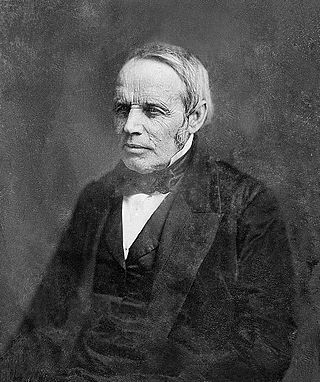
Azariah Cutting Flagg was an American newspaper printer and editor, and politician.

The Historic New Orleans Collection (THNOC) is a museum, research center, and publisher dedicated to the study and preservation of the history and culture of New Orleans and the Gulf South region of the United States. It is located in New Orleans' French Quarter. The institution was established in 1966 by General and Mrs. L. Kemper Williams to keep their collection of Louisiana materials intact and available for research and exhibition to the public.

The F. Julius LeMoyne House is a historic house museum at 49 East Maiden Street in Washington, Pennsylvania. Built in 1812, it was the home of Dr. Francis Julius LeMoyne (1798–1897), an antislavery activist who used it as a stop on the Underground Railroad. LeMoyne also assisted in the education of freed slaves after the American Civil War, founding the historically black LeMoyne–Owen College in Memphis, Tennessee. His house, now operated as a museum by the local historical society, was designated a National Historic Landmark in 1997. It is designated as a historic public landmark by the Washington County History & Landmarks Foundation.
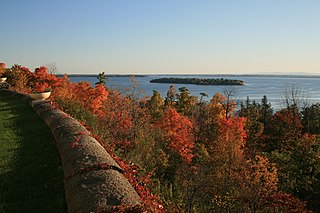
Crab Island is a roughly 40-acre (0.16 km2) limestone island situated in Lake Champlain just outside Plattsburgh Bay in the town of Plattsburgh in Clinton County in upstate New York. During the War of 1812, the island was utilized as a military field hospital for convalescent soldiers as well as both British and American casualties of the Battle of Plattsburgh. The island is the site of a mass grave believed to contain the remains of roughly 150 of those casualties.

The Herndon Depot Museum, also known as the Herndon Historical Society Museum, is located in the town of Herndon in Fairfax County, Virginia. Built in 1857 for the Alexandria, Loudoun & Hampshire Railroad, the depot later served the Richmond and Danville Railroad, the Southern Railway and the Washington and Old Dominion Railroad. In 1875, the original shed was replaced with the current depot.

New York State Markers was a state historic marker program. This was managed by the Education Department's State History office from 1926 to 1966. There are an estimated 2,800 historic markers around the state. The markers tell about historic events and locations and provide the public with knowledge about the state of New York. It is no longer a requirement to have a new marker approved by the Education Department and SED as long as they are located on private property. Historic Markers have become a major way to inform the public and tourists of local history.
Dean Mosher is an American artist, author, and historian from Fairhope, Alabama. He has paintings in permanent collections in several museums including the Smithsonian National Air and Space Museum, the United States Coast Guard Academy, United States Naval Academy, and the University of Virginia.

The Fort Lee Museum is a historical museum in Fort Lee, New Jersey on Palisade Avenue within Monument Park. The museum opened in April 1999 and is operated by the Fort Lee Historical Society. The museum closed during the 2020-2022 Covid-pandemic and has not re-opened.
References
- ↑ "War of 1812 Museum". Archived from the original on 2007-01-28. Retrieved 2007-03-03.
- ↑ Caiella, James M. (March 2013). "War of 1812 Gem". Naval History Magazine. 27 (2).
- ↑ Dan Heath (December 21, 2006). "The War of 1812 Museum dedicates its newest addition". The Press Republican. Retrieved 2007-03-03.[ dead link ]
- ↑ "Historic Marker: War of 1812 Trail". William G. Pomeroy Foundation. Retrieved October 24, 2023.
- ↑ Strzepa, Liz (September 11, 2023). "Museums, organizations remember the Battle of Plattsburgh on 209th anniversary". NBC5. Retrieved October 24, 2023.